|
|
|
Sort Order |
|
|
|
Items / Page
|
|
|
|
|
|
|
| Srl | Item |
| 1 |
ID:
126603
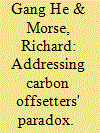

|
|
|
|
|
| Publication |
2013.
|
| Summary/Abstract |
The clean development mechanism (CDM) has been a leading international carbon market and a driving force for sustainable development. But the eruption of controversy over offsets from Chinese wind power in 2009 exposed cracks at the core of how carbon credits are verified in the developing economies. The Chinese wind controversy therefore has direct implications for the design and negotiation of any successor to the Kyoto Protocol or future market-based carbon regimes. In order for carbon markets to avoid controversy and function effectively, the lessons from the Chinese wind controversy should be used to implement key reforms in current and future carbon policy design. The paper examines the application of additionality in the Chinese wind power market and draws implications for the design of effective global carbon offset policy. It demonstrates the causes of the wind power controversy, highlights underlying structural flaws, in how additionality is applied in China, the Offsetters' Paradox, and charts a reform path that can strengthen the credibility of global carbon markets.
|
|
|
|
|
|
|
|
|
|
|
|
|
|
|
|
| 2 |
ID:
092832


|
|
|
|
|
| Publication |
2009.
|
| Summary/Abstract |
The clean development mechanism (CDM) contributes to technology transfer by financing emission reduction projects using technologies not available in the host countries. This paper provides the most comprehensive analysis of technology transfer in the CDM to-date, covering 3296 registered and proposed projects. Roughly 36% of the projects accounting for 59% of the annual emission reductions claim to involve technology transfer. Technology transfer is more common for larger projects and projects with foreign participants. Technology transfer is very heterogeneous across project types and usually involves both knowledge and equipment. As the number of projects increases, technology transfer occurs beyond the individual projects. This is observed for several of the most common project types in China and Brazil with the result that the rate of technology transfer for new projects in those countries has fallen significantly.
|
|
|
|
|
|
|
|
|
|
|
|
|
|
|
|
| 3 |
ID:
095941
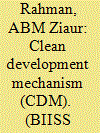

|
|
|
| 4 |
ID:
125843
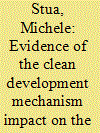

|
|
|
|
|
| Publication |
2013.
|
| Summary/Abstract |
The extension of the Kyoto Protocol till 2020 has left uncertainty dominating the future of climate change negotiations. Meanwhile on-going debate on the variety of measures introduced by the Protocol demonstrate that there is no consensus among academics and policy makers on the efficacy of those measures. By focusing on a specific but extensive case-study, which encompasses the whole contribution of the clean development mechanism (CDM) to the Chinese electricity production sector, this paper aims to reflect upon the effectiveness of that mechanism during its originally planned lifetime (which was to be the end of 2012). The paper contributes to the international debate by offering a new evidence-based perspective on the efficacy of the CDM in a strategic sector of the most relevant non-Annex I country. The obtained empirical results can serve as evaluation instruments for both academics and policy makers involved in the elaboration of a new Protocol and its related mechanisms, while at the same time offering a stimulus for further analyses sharing similar objectives. The results reveal a new perspective on the Chinese electricity system's low-carbon transition, while prompting debate over the original efficacy of the CDM.
|
|
|
|
|
|
|
|
|
|
|
|
|
|
|
|
| 5 |
ID:
125640


|
|
|
|
|
| Publication |
2013.
|
| Summary/Abstract |
Project developers in South Africa are puzzled with the long process of evaluating and registering their CDM projects. In addition to other obstacles, we find that South African big businesses are rather reluctant to engage in any new business activities such as CDM projects and municipalities often lack the necessary flexibility. This offers opportunities for small-scale project developers who spot the opportunities and find creative solutions to overcome these difficulties.
|
|
|
|
|
|
|
|
|
|
|
|
|
|
|
|
| 6 |
ID:
094277
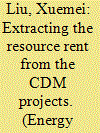

|
|
|
|
|
| Publication |
2010.
|
| Summary/Abstract |
The revenue generated from a CDM project in China will be shared by the government and the project owner, and is also subject to the corporate income tax. This paper studies the impacts of the revenue sharing policy and income tax on the CDM market. The economic model presented in this paper shows that higher-cost CDM projects will be more affected by the CDM policies than lower-cost projects. In addition, the majority of CERs will be generated from lower-cost projects. This kind of distribution of CERs across different types of CDM projects, which is in line with the current picture of the CDM market in China, is not consistent with the goal of sustainable development. A simulation shows that a type-by-type tax/fee scheme would be more effective in assisting sustainable development than the current CDM policies. The study also suggests the government use negative tax/fee with the type-by-type scheme to subsidize the CDM projects that generate large sustainability benefits but would otherwise not be developed due to high costs. If all of the revenue from the CDM is recycled, it is estimated that CERs generation will increase by 98.28 MtC, mainly from the CDM projects that have substantial sustainability benefits for the host country.
|
|
|
|
|
|
|
|
|
|
|
|
|
|
|
|
| 7 |
ID:
121381
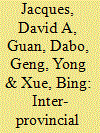

|
|
|
|
|
| Publication |
2013.
|
| Summary/Abstract |
With ever growing urgency, climate change mitigation is fast becoming a priority for China. A successful policy of implementing and expanding sustainable development and the use of renewable energy is therefore vital. As well as long-term and near-term targets for installed capacity of renewable energy, in its 12th five-year plan, China has created strict and ambitious carbon intensity targets for each province. This study proposes an inter-provincial clean development mechanism to assist in meeting these targets. This mechanism will create potential co-benefits of assisting in sustainable development in lesser developed provinces, increasing local air quality and supporting the growth of China's renewable energy sector. This paper also highlights the potential that this inter-provincial clean development mechanism has in accelerating the growth of the domestic solar photovoltaics (PV) sector, for which the market in China is still in its infancy.
|
|
|
|
|
|
|
|
|
|
|
|
|
|
|
|
| 8 |
ID:
093499
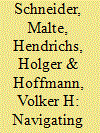

|
|
|
|
|
| Publication |
2010.
|
| Summary/Abstract |
From a slow start, the clean development mechanism (CDM) market has recently experienced enormous growth. However, the CDM market has been increasingly criticised, resulting in a lively debate about how to reform, complement, or replace it. In order to increase transparency and assist policy-makers in better understanding the current market, we depart from the traditional project-level perspective on CDM and analyse commercial activities by utilising data from UNEP Risoe's CDM Bazaar. To this end, we first establish a seven-step value chain by conducting a factor analysis on the commercial activities indicated in the Bazaar and, second, identify nine prevalent business models with a cluster analysis of all 495 participating organisations. Based on these analyses, we discuss potential impacts on the value chain of different policy scenarios that rely on carbon credits as incentive. We find that the importance of specific regulatory CDM know-how and general business activities such as finance varies strongly with the different policy scenarios. Our analysis serves to sensitise policy-makers and business about implications of different regulatory designs.
|
|
|
|
|
|
|
|
|
|
|
|
|
|
|
|
| 9 |
ID:
094398
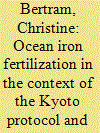

|
|
|
|
|
| Publication |
2010.
|
| Summary/Abstract |
Ocean iron fertilization is currently discussed as a potential measure to mitigate climate change by enhancing oceanic CO2 uptake. Its mitigation potential is not yet well explored, and carbon offsets generated through iron fertilization activities could currently not be traded on regulated carbon markets. Still, commercial interests in ocean iron fertilization already exist, which underlines the need to investigate a possible regulatory framework for it. To this end, I first discuss important basic aspects of ocean iron fertilization, namely its scientific background, quantitative potential, side effects, and costs. In a second step, I review regulatory aspects connected to ocean iron fertilization, like its legal status and open access issues. Moreover, I analyze how the regulations for afforestation and reforestation activities within the framework of the Kyoto Clean Development Mechanism (CDM) could be applied to ocean iron fertilization. Main findings are that the quantitative potential of ocean iron fertilization is limited, that costs are higher than initially hoped, and that potential adverse side effects are severe. Moreover, the legal status of ocean iron fertilization is currently not well defined, open access might cause inefficiencies, and the CDM regulations could not be easily applied to ocean iron fertilization.
|
|
|
|
|
|
|
|
|
|
|
|
|
|
|
|
| 10 |
ID:
092745


|
|
|
|
|
| Publication |
2009.
|
| Summary/Abstract |
China is now the largest CO2 polluter in the world. However, the renewable energy policies in China are controversial and one can easily draw the wrong conclusions that Chinese renewable energy development has taken off from a surface assessment of the policies. By investigating and summarizing the first-hand experiences of participation in the Chinese renewable market (mainly wind farm development) in the past five years, this paper provides another dimension of policy analysis and independent review of the current issues facing the market. An investigation of policy changes and consequences clearly demonstrates the transformation of the Chinese renewable market. The domestic manufacturing quality and unprofessional design of wind farms made most developers' financial returns unrealistic in the wind market. Despite the difficulties and inconsistency in the system, China is tackling environmental issues seriously and heading in the right direction. With centrally controlled management, the Chinese strategies do not have to be justified financially. It is envisioned by the authors that re-organizing over 70 existing Chinese wind turbine manufacturers is unavoidable. Establishment of an internal renewable market, such as Renewable Obligation Certificate (ROC) system in the UK whose effectiveness is another subject of debate, would be an effective means by which the Chinese government in their post-2012 strategy could make the wind market more financially viable.
|
|
|
|
|
|
|
|
|
|
|
|
|
|
|
|
| 11 |
ID:
126597
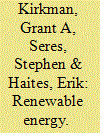

|
|
|
|
|
| Publication |
2013.
|
| Summary/Abstract |
Geothermal, Hydro, Solar and Wind projects located in developing (4808 CDM projects) and developed (2952 Annex I projects) are compared in terms of size (capacity - MWe), capital intensity (US$/MWe) and average investment (US$ per project). The average investment in both CDM and Annex I projects increased rapidly between 2000 and 2012. Most investment in renewable energy projects in both developed and developing countries comes from domestic sources, although the share of foreign investment has been rising for both CDM and Annex I projects. A project with foreign investors often attracts funds from multiple countries, including the host country.
|
|
|
|
|
|
|
|
|
|
|
|
|
|
|
|
| 12 |
ID:
118833
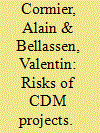

|
|
|
|
|
| Publication |
2013.
|
| Summary/Abstract |
The Clean Development Mechanism (CDM), launched in 2001, has attracted more than 7000 projects. Many, however, did not fully deliver the emissions reductions promised in their project design documents: out of 1.8 billion of expected Certified Emissions Reductions (CER) by April 1, 2011, only 576 million had been issued. This study classifies the risks incurred by CDM projects, attributes a share of the non-delivered CER to each risk, and identifies the most influential factors driving each risk. 29% of expected CER will never be issued due to failure of projects (negative validation, project withdrawn, …), 12% were not issued on time due to delays during the approval process (validation and registration), 27% were not issued on time due to delays at issuance, and only 1% will never be issued due to underperformance of projects in terms of CER delivered per day. Technology is identified as a key driver for all these risks: some technologies are less risky than others. Time is mainly influencing approval process and issuance delay. Other factors such as location, size of the project, auditor or consultant are occasionally important, but not for each risk.
|
|
|
|
|
|
|
|
|
|
|
|
|
|
|
|
| 13 |
ID:
088053
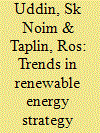

|
|
|
|
|
| Publication |
2009.
|
| Summary/Abstract |
This article analyses and discusses trends in renewable energy strategy development in Bangladesh and the prospective role of the clean development mechanism (CDM) under the Kyoto Protocol. Use of renewables for electricity generation results in less greenhouse gas emissions compared with fossil fuel energy systems and often offers additional synergistic benefits. Despite the large potential for development of renewable energy sources in Bangladesh, currently their contribution to electricity generation remains insignificant. Existing policies and programs on renewable energy in Bangladesh are reviewed in relation to the specific requirements needed for CDM. A number of barriers are identified that impede the implementation of the CDM mechanism. Overall, it is recommended that more appropriate energy strategies, including a new national renewable energy strategy, need to be formulated and implemented and more suitable institutional settings need to be provided to promote energy sustainability for Bangladesh. Also, the suggestion is made that incorporation of objectives for CDM promotion in the new national renewable energy strategy to tie in with Bangladesh's CDM strategy should assist in advancement of renewables.
|
|
|
|
|
|
|
|
|
|
|
|
|
|
|
|
|
|
|
|
|